How To Increase Home Energy Efficiency with Simple Upgrades?
RH Business Marketing Solutions
Home energy efficiency is a critical aspect of home improvement and one that can have a significant impact on your energy bill. Making small upgrades to your home can help reduce energy waste, lower your monthly energy costs, and make your home more environmentally friendly.
In this article, we'll discuss the various ways to increase home energy efficiency and what upgrades you can make to your home to achieve this goal.
Why is Energy Efficiency Important?
Energy efficiency is important for many reasons. It helps you save money on your energy bills and reduce your carbon footprint. Additionally, energy-efficient homes are more comfortable, quieter, and require less maintenance, making them more attractive to potential buyers in the future.
Low-Cost Upgrades for Increased Energy Efficiency:
1. Replace Old Lightbulbs:
One of the simplest and most cost-effective upgrades you can make to your home is to replace your old lightbulbs with energy-efficient alternatives, such as LED lights.
LED lights consume up to 80% less energy than traditional incandescent lightbulbs, which can make a significant impact on your energy bill. Additionally, LED lights have a longer lifespan than traditional lightbulbs, which means you'll need to replace them less often.
2. Install a Programmable Thermostat:
A programmable thermostat is another low-cost upgrade that can help you save money on your energy bill. This device allows you to control the temperature of your home automatically, which can help reduce energy waste.
When you're away from home, you can program the thermostat to turn down the heat, and when you're home, you can set it to keep you comfortable. Studies have shown that using a programmable thermostat can reduce your energy bill by up to 15%.
3. Seal Air Leaks:
Air leaks can cause significant energy waste in your home, as they allow hot air to escape during the winter and cool air to escape during the summer. Sealing air leaks is a simple and affordable upgrade that can help reduce your energy bill.
You can use weatherstripping, caulk, or spray foam to seal any air leaks in your home. You should focus on sealing air leaks around windows, doors, and electrical outlets, as these areas are the most common sources of air leaks.
4. Upgrade Your Windows:
If your windows are old and drafty, they may be causing significant energy waste in your home. Don’t listen to home improvement telemarketing agents or real estate brokers if they try to convince you otherwise. Upgrading your windows to more energy-efficient models can help reduce energy waste and lower your energy bill.
Look for windows that are ENERGY STAR-certified and have low-E coatings to ensure they are as energy-efficient as possible. In addition, consider adding storm windows or installing insulated window coverings to help improve the energy efficiency of your windows.
5. Install Insulation:
Insulation is another essential component of a home's energy efficiency. If your home is under-insulated, you may be losing a significant amount of energy, which can raise your energy bill.
Installing additional insulation in your home can help reduce energy waste and lower your energy bill. You should focus on insulating your attic, walls, and floors, as these areas are the most critical for maintaining a comfortable home temperature.
6. Upgrade Your HVAC System:
Finally, upgrading your HVAC system can help increase the energy efficiency of your home. Look for an HVAC system that is ENERGY STAR-certified and has a high SEER (Seasonal Energy Efficiency Ratio) rating, as this will indicate that the system is highly energy-efficient.
Additionally, regular maintenance of your HVAC system, such as cleaning air filters and scheduling tune-ups, can help ensure that it's running at peak efficiency, which can lower your energy bill.
Conclusion:
There are many simple upgrades you can make to your home to increase its energy efficiency, and they don't have to break the bank. By replacing old lightbulbs, installing a programmable thermostat, sealing air leaks, upgrading your windows, installing insulation, and upgrading your HVAC system, you can reduce energy waste and lower your energy bill. With these upgrades in place, you'll enjoy a more comfortable home and be doing your part to help the environment.
In conclusion, these home improvement efforts can result in significant energy savings and increased comfort in your home. By taking advantage of these low-cost upgrades, you can make your home more energy-efficient and reduce your monthly energy costs. So don't hesitate, start making these simple upgrades today and enjoy the benefits of a more energy-efficient home.
FAQs
What are the benefits of increasing home energy efficiency?
Lower energy bills, increased comfort, reduced environmental impact, improved indoor air quality, increased home value.
What is the first step in increasing home energy efficiency?
Conducting an energy audit to identify areas where energy is being wasted would be the first step in increasing home energy efficiency.
Can increasing home energy efficiency be expensive?
Not necessarily. Some upgrades, such as sealing air leaks, can be done for free or for very little cost. More expensive upgrades, such as replacing windows, can be cost-effective in the long run.
Can I do these upgrades myself or do I need to hire a professional?
Some upgrades, such as sealing air leaks and installing a programmable thermostat, can be done by homeowners. More complex upgrades, such as upgrading your HVAC system, should be done by a professional.
How long will it take to see the benefits of increasing home energy efficiency?
The benefits will be seen almost immediately, such as lower energy bills, and will continue to be seen for as long as the upgrades are in place.
Is it possible to make my home 100% energy efficient?
It's not possible to make a home 100% energy efficient, but you can get close by making a combination of upgrades and being mindful of energy usage.
Are there any government incentives available for increasing home energy efficiency?
Yes, some government programs offer incentives, such as tax credits, for making energy-efficient upgrades to your home. Check with your local government to see what's available.
How often should I check and maintain my HVAC system to ensure it's running efficiently?
It's recommended to have your HVAC system inspected and tuned up at least once a year by a professional. Cleaning air filters monthly can also help improve its efficiency.
Can upgrading my windows alone make a significant impact on my energy bill?
Yes, upgrading your windows can make a significant impact on your energy bill. New windows are more energy-efficient and can help reduce heat loss in the winter and heat gain in the summer.
Are there any energy-efficient upgrades that also improve home safety?
Yes, some upgrades, such as installing a programmable thermostat and upgrading your electrical system, can improve both energy efficiency and home safety.
How can I determine if my home needs insulation?
An energy audit can identify areas where insulation is needed. You can also look for signs such as drafty rooms, high energy bills, and hot and cold spots in your home.
How much can I expect to save on my energy bill by making these upgrades?
The amount you can expect to save on your energy bill will depend on the specific upgrades you make and the size of your home. However, even small upgrades can result in significant savings over time.












